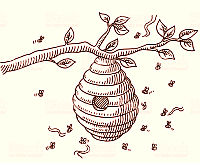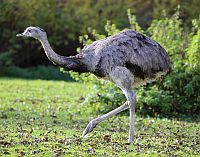Wikipedia
R.H. Allen:
Star Names
Ian Ridpath:
Star Tales
Universe Guide
Sea and Sky:
Constellations
IAU
Map
|
Wikipedia |
R.H. Allen: Star Names |
Ian Ridpath: Star Tales |
Universe Guide |
Sea and Sky: Constellations |
IAU Map |


|
|
Star LoreCruxSouthern Hemisphere |
|


 Australian Flag Australian Flag |
Crux is a constellation in the southern sky. Its name is Latin for cross. While the constellation was barely noticed in Europe and Asia, it has always played an important role in navigation and mythology in the southern heminsphere. |


|
|
Crux, Centaurus,
and the Coalsack Nebula
The further south one travels, the brighter the Southern Cross shines. Thus, the constellation plays a prominent
role in star lore in the southern hemisphere.
|
 Alpha and Beta Centauri pointing towards the Cross
Alpha and Beta Centauri pointing towards the CrossSource: earthsky.org  Right: Coalsack Nebula and Southern Cross Source: Wikipedia |

|

|
|
Alpha Centauri and Hadar (β Centauri) are among the brightest stars in the southern sky - Alpha Centauri is the third brightest star in the night sky. The two stars are called the Pointers, as a line connecting the two leads directly to the southern Cross. |

|
|
The Coalsack Nebula is the most prominent dark nebula in the skies, visible to the naked eye near the Southern Cross, as a dark patch obscuring a brief section of the Milky Way. |


| Africa |

|
|
Bedoin
The Tuaregs call the four most visible stars of Crux iggaren - four
Maerua crassifolia trees.
|
 Maerua crassifolia
Maerua crassifoliaPlants of s. Morocco |


|
|
Mursi
The Mursi people of modern-day Ethiopia call the star Delta Crucis (also known as "Decrux")
Imai.
|
 Omo river;
Source: lifegate.com
Omo river;
Source: lifegate.com
|
The Mursi use a series of southern stars to mark their calendar to track seasonal flooding of the Omo river.
 In 2018, the Working Group on Star Names of the International Astronomical Union approved the name Imai for Delta Crucis.  Source: Wikipedia |

|
|
Sotho, Tswana,
Venda, /Xam, Khoikhoi
The Sotho, Tswana and Venda call these stars Dithutlwa, the Giraffes. The bright stars of of the Cross are seen as male giraffes,
the two Pointers are female. The Venda called the fainter stars of the Southern Cross Thudana, The Little Giraffe.
|

|


| Australia |

|
|
Adnyamathanha
The Adnyamathanha in South Australia often refer to the Southern Cross
as Wildu Mandawi, the place where deceased spirits travel up into the heavens.
|

|
|
Aranda
The Aranda people of the central Australian part of the Northern Territories see the talon of an eagle in the Southern Cross
with the Coalsack Nebula being its nest and the pointers being its throwing stick.
According to Haynes et al., the Aranda and their neighbors, the
Luritja people formed a quadrangular constellation called Iritjinga
out of γ Centauri,
δ Centauri, γ Crucis and
δ Crucis. Iritjinga means "Eagle-Hawk", another word for the
Wedge tailed eagle.
|
 Eagle-Hawk in the Arms of the Nortnern Territory
Eagle-Hawk in the Arms of the Nortnern TerritorySource: Wikipedia |


|
|
Boorong
The Boorong of north-Western Victoria see two great hunters in the pointer stars of Centaurus.
They tell a story of Bunya, who was chased by the emu Tchingal.
|
 Opossum Tree
Opossum Tree© Narritjin Maymuru |


|
|
Kaurna
The Kaurna from the Adelaide region see the footprint of the wedge-tailed eagle in the Southern Cross,
which they call Wilto.
|
 Eagle Prints
Eagle Prints© Clifford Possum |
|
|
Yankunytjatjara
The Yankunytjatjara add a variation to the eagle talon story. To them, the Southern Cross is not the footprint of an eagle, but the print of an emu.
|


|
|
Torres Strait Islanders
for the Torres Strait Islanders, the Southern Cross is part of the Tagai constellation (see Centaurus).
|


|
|
Nyulnyul
Aboriginal people at Australia's northwest coast tell a story about how the fire came to the people. They see the Southern Cross as the camp of two
mothers who came to earth in search of food. The fire sticks they carried got out of control and the fire was captured by the people.
|
 Rock painting from the
Rock painting from theKimberley Region Source: Wikipedia |

|
|
Galbu
To the Galbu (part of the Yolngu language group in the Northern Territories),
the stars of the Southern Cross form a stingray that is eternally pursued by a shark, represented by the Pointers.
|
 Stingray
Stingray© Donald Blitner |
|
|
Ngarrindjeri
Half a continent away, the Ngarrindjeri people in South Australia have the same story of
a stingray named Nunganari, pursued by two sharks.
|

|
|
Oenpelli
To the Oenpelli in the Northern Territory, the Coalsack Nebula represents a fruit tree.
Garakma, a celestial family, feeds on the fruit and on waterlily bulbs from the Milky Way.
|


|

The Wardaman people of the Northern Territory called the constellation we know as Crux Ginan - a Bag of Songs.
Australian writer W. E. Harney reports that to the Wardaman people, the coalsack Nebula
represents head and shoulders of a law-man watching the people to ensure they do not break traditional law.
|

|


|
|
Warnindhilyagwa
The Warnindhilyagwa see the Coalsack Nebula as a fish called Alakitja, which is
is speared by two brothers. The blog Aboriginal Astronomy tells the story:
|

|
The Two Brothers were hungry. They had been busy making mountains and rivers on Earth and they now looked for food. They crept up to the water hole
and saw the gigantic fish Alakitja. They drove their spears into Alakitja and pulled the fish from the water hole.
 They shared the fish and each brother made his own campfire. They can still be seen there today. The two campfires are the stars Delta Crucis and Gamma Crucis.  The two brightest stars of the cross, Alpha and Beta Crucis, are the Two Brothers. The fish is the dark patch close by (the Coal Sack). The two pointers, Alpha and Beta Centauri are friends of the brothers who are waiting for their share of Alakitja the fish.  Sources: Aboriginal Astronomy, Dianne Johnson p. 163 |


|
|
Wotjobaluk
The Wotjobaluk in what is now Victoria
interpret the Coalsack Nebula as the top of a giant pine tree that can be used to climb to the sky.
|


| Pacific |

|
|
Bugis
The Bugis sailors used the Southern Cross for navigation. The four main stars, together with μ Crucis
were called bintoéng bola képpang - the "incomplete house star."
|


|
|
Hawaii
In Hawaii, the Southern Cross is called Hanaiakamalama, meaning "cared for by the moon."
|


|
|
Solomon Islands
The people of the Solomons see the Southern Cross as a net used to catch Palola worms.
|


|

|


|
|
Māori
In Māori, The Southern Cross is called Māhutonga and the pointers are acalled Te Taura o te Waka o Tamarēreti.
|

|


| South America |


|
|
Bakairi
The Bakairi people in what is now the Brazilian state of Mato Grosso had a sprawling
constellation representing a bird snare. It included the bright stars of Crux and the southern part of Centaurus, together with stars from
Circinus,
Lupus,
Musca,
Chamaeleon,
Volans and
Mensa.
|

|

|
|
Kalapalo
The Kalapalo people, also of Mato Grosso saw the Coalsack Nebula as a beehivehad and the stars
of the Southern Cross as Aganagi, angry bees that had emerged from the hive.
|
 Bee Hive
Bee HiveSource: clipart.email |


|
|
Bororo
The Bororo people in what is now the Brazilian state of Mato Grosso had a constellation called
the Great Rhea, encompassing the stars of Centaurus and
Circinus and the bright stars Alpha and
Beta Centauri, which made up one foot of the big bird.
|
 Great Rhea
Great RheaSource: Wikipedia |


|
|
Mocoví
Wikipedia reports that the Mocoví
of Argentinas Gran Chaco region also saw a rhea in Crux. Their rhea's body
consisted of the four main stars of Crux, while its head was γ Centauri and its feet were
the bright stars of Musca.
Alejandro López relates Mocoví cosmology to the the Coalsack Nebula and a mythical being called the Mañic He writes that the Mañic: "... is the master of the South American rheas.It used to shelter in a number of burrows, under the roots of an ombú. |

A Mocoví mythical tale has that a powerful man decided to face the Mañic.
He chased the Mañic throughout the world and the cornered Mañic climbed up the ombú trunk (the tree of the world) to the sky.
 Today, the shadow-soul (la 'al) of the Mañic can be seen in the Milky Way's dark clouds, with its head in what we know as the Coalsack. Alpha and Beta Centauri are dogs chasing the Mañic and bite at its neck."  Source: Steven R. Gullberg et al. A Comparison of Dark Constellations of the Milky Way |
 The Mañic; art by Jessica Gullberg,
The Mañic; art by Jessica Gullberg,constellation from López and Alterlieb Source: researchgate.net |


|
|
Mapuche
In the language of the Mapuche, the Southern Cross is called Melipal, meaning "four stars.
|


|
|
Inca
In Quechua, the language of the Inca civilization, Crux is known as Chakana.
 Literally, Chakana means "stair" (chaka = bridge, link; hanan = high, above).  Source: Wikipedia |
 Stairs on the Inca Trail
Stairs on the Inca TrailSource: denomades.com |


 |
Back to Early Observations and Modern Use | Forward to Crux Myth Start Page |
 |


|
Back to Star Lore |
Back to Mythology |

Back to Crux |
Back to Space Page |
Back to English |
 Back to Start Page |